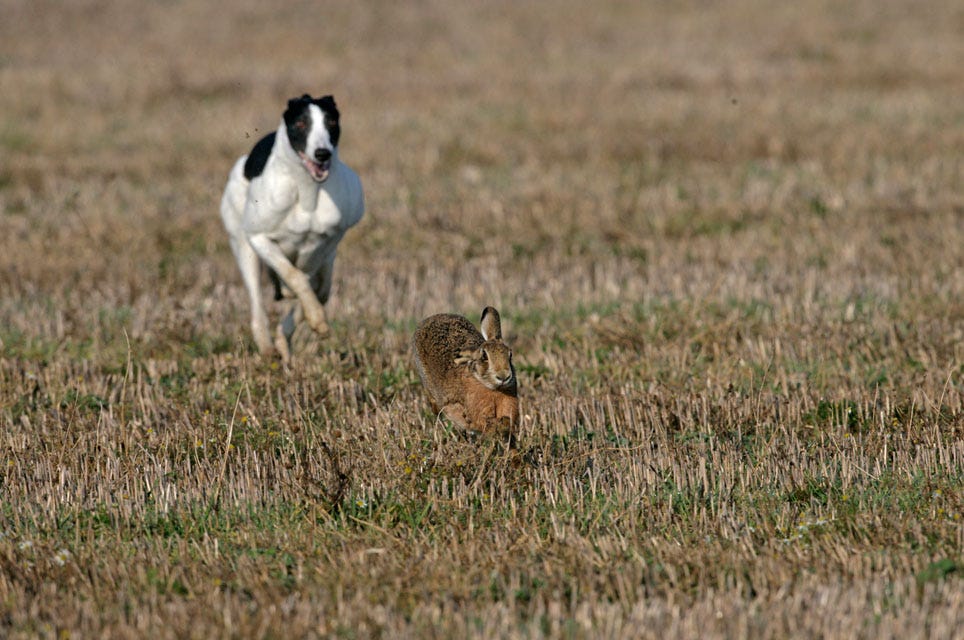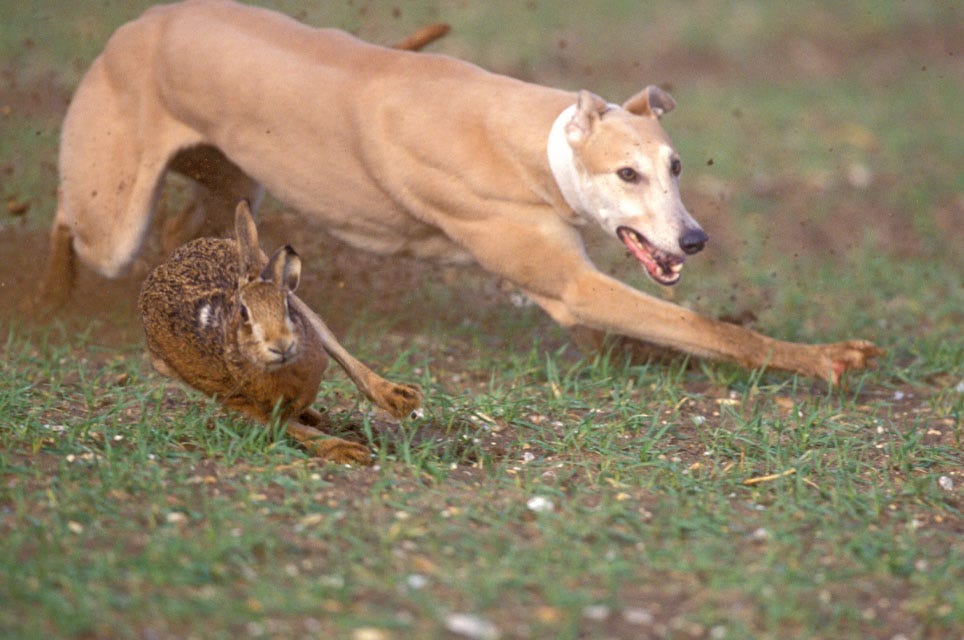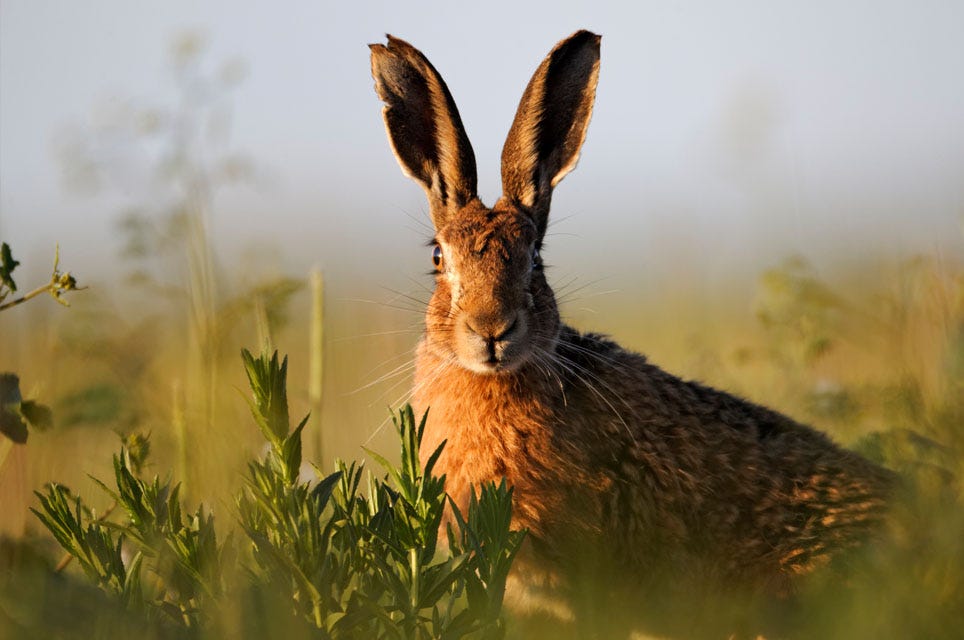Hare coursing and hare hunting - is there police bias?
Hare coursing and hare hunting - is there police bias?
During a Westminster Hall debate on a pair of anti-hunting petitions promoted by Protect the Wild (formerly Keep The Ban), the under-secretary for environment Rebecca Pow said that the Police, Crime, Sentencing and Courts Act would bring in new legislation that would “genuinely help [police] as regards any hare coursing”. But this government hasn’t hinted at equivalent legislation targetting fox, hare and deer hunts. And this taps into a question that many within the anti-hunting debate have asked: do the police give greater attention to coursers and, if so, why?
SCENT AND SIGHT HOUNDS
Hare hunting and hare coursing differ by the types of hounds involved: scent hounds and sight hounds. Hare hunting uses scent hounds that track prey by scent, as the name suggests. In the UK, the three breeds of scent hounds used for hunting are harriers, beagles and bassets. (It is worth noting, though, that harrier packs may also hunt foxes.) Meanwhile, sight hounds track their prey by sight and breeds such as greyhounds, lurchers and whippets are commonly used for coursing in this country.
It is worth noting that harrier packs, which hunt on horseback, take both foxes and hares as their quarry. Beagles and bassets take hares as their quarry exclusively.
Before the Hunting Act, both hunting and coursing in the UK existed as formally organised events. Similarly, hunt saboteurs targeted both types of events. Today, however, the landscape is very different. Hunts whose traditional quarry is hare remain active behind the smokescreen of trail hunting or, occasionally, claim that they hunt rabbits. Bailey’s directory shows 60 beagle packs, 15 harrier packs and nine basset packs active in the UK at the time of publishing. Hare coursing, on the other hand, has completely disappeared as an above-ground activity.
Nonetheless, coursing continues in an underground and disorganised way.
OPERATION GALILEO
Suffolk Police said that, across its ‘borderless’ network of seven forces throughout the East of England, there were 1415 known incidents of hare coursing during the 2021-22 coursing season. The news will often report on the aggressive behaviour of coursers, who are likely to assault those that confront them.
By comparison, according to police statistics, there are far fewer reports of illegal hare hunting.
Keep The Ban spoke with chief inspector Phil Vickers, national lead on Operation Galileo, which is the nationwide police effort against hare coursing. And Vickers pointed to the previously mentioned combination of factors including incident figures as a key reason why there is heightened police focus on coursing.
“Looking at the impact on victims – rural communities and wildlife – as well as the volume of demand (number of reports), Hare Coursing stands significantly higher than the other offences mentioned,” Vickers said. “In Lincolnshire, there were more than 1500 hare coursing reports during the 2021/22 season (Sept to March) versus a handful of other hunting with dogs reports.”
Impact on victims is foregrounded in public discourse about coursing. Brian Calver of the Suffolk Rural and Wildlife Team, said coursing “damages property, threatens people's incomes and subjects people to fear”. A press release by Essex Police on 27 April 2022 provides an example of these concerns. The courser involved broke through a padlocked gate and drove across a field as his lurcher coursed hares. An officer from the Rural Engagement Team said this “not only had the potential to damage crops but also caused ruts, which damage soil structure and can affect future crop yields.”
Police are also keen to highlight contemporary coursing’s connection to other criminal activity. Gambling is particularly closely associated, with claims that coursing events are streamed online for people around the world to bet on. There are also instances of coursers linked to drug and firearm offences.
By comparison, hunting with hounds appears to be a more sedate affair. Hunts will have agreements with the landowner to use the land and they’re unlikely to drive vehicles across crop fields (although some fox-based harrier packs are accompanied by terriermen).
As a result, landowners and members of the public are much more likely to report coursing than hunting with hounds. And Vickers believes this is behind the perception that police are more likely to act on coursers than hunters. He told Keep The Ban that “coursing, simply because of the volume of reports and the volume of media (including Social Media) reports, highlights policing activity.”
HARE HUNTING
Anti-hunting groups disagree. Campaign group Action Against Hare Hunting told Keep The Ban that it is “delighted” police take coursing seriously but “not pleased about is the vast discrepancy” with police action on hare hunting. Like Vickers, Action Against Hare Hunting pointed to public statistics on coursing and hunting. But unlike Vickers, the anti-hunting group drew different conclusions.
“The police have never to our knowledge initiated action against people who hunt with scent hounds,” the group said. “We are only aware of one prosecution, which led to a caution. When we present that fact to the public they are stunned. With sight hounds... the opposite is true: police take action resulting in numerous arrests and prosecutions.”
In 2009, police cautioned the huntsman of the Wick and District Beagles in what the Telegraph described as the “first case of its kind”. It also appears to have been the last.
According to the Campaign to Strengthen the Hunting Act, the League Against Cruel Sports provided evidence for a prosecution of the Royal Artillery Beagles in November 2013 but the case was dropped. The table also shows a successful case against the Minehead Harriers in January 2008. However, the Minehead Harriers’ take foxes as its quarry. The same is true of the Ross Harriers, who were connected to three men found guilty in 2015 of transporting a live fox.
That means only one pack whose quarry is hare has faced legal repercussions under the Hunting Act.
By comparison, the Hunting Act has led to the prosecution of hundreds of coursing-related incidents. As the Countryside Alliance has noted, Hunting Act statistics show that between 2005 and 2017, only 24 of 476 convictions were related to hunting with hounds. The other 452 were mostly coursing-related.
FOLLOWING THE EVIDENCE
By itself, the data shows hare coursing to be a greater problem than hare hunting. But data alone isn’t the whole story, as Action Against Hare Hunting explained:“Public knowledge of illegal hunting with harriers, beagles and bassets, is often not understood by the public and the police don't tell people to look out for them.”
Vickers confirmed that public reporting plays a crucial role in police action against coursing. “Much of our work relies on evidence from members of the public,” he said, “even if only to direct Policing activity to suspicions of criminality.”
With this in mind, Action Against Hare Hunting pointed out the impact of entrenched class bias in the UK: “It's still hard for most people to imagine that Eton College, for example, is facilitating organised crime amongst its pupils by providing them with a beagle pack to go out and hunt hares. Presented with that fact (and it is a fact) most people are still very surprised. So respectability is a huge factor and we believe this influences police as well. Also in the popular imagination people from low-income backgrounds are much more likely to be engaged in criminal activity.”
Vickers would disagree with this. He said that police “follow the evidence” when tackling coursing and that the policing approach “involves identifying those who cause the greatest harm to rural communities and targeting them”. Much of this is collected into Operation Galileo, the nationwide strategy to combat coursing that makes use of different tactics to disrupt coursers. Vehicle number plates are tagged, for example, enabling police to track their movements. Operation Galileo enables this type of information to be shared nationwide.
Operation Galileo began in 2019 as a co-ordinated effort to clamp down on coursing rather than simply pushing it from county to county. “Whilst Police forces were tackling Hare Coursing in their area, in reality this simply pushed offending around the country as offenders are willing to travel hundreds of miles if they feel they will escape Police attention,” Vickers said. As a result, an initial 12 police forces agreed to Operation Galileo in 2019 as a co-ordinated approach that would tackle coursing and associated “wider rural crime”.
Vickers believes the growth of the strategy proves its impact. Today, 32 forces across the country participate in Operation Galileo and it is regularly name-checked in news articles on coursing. But it also appears to have had an impact on policy. The chief inspector told Keep The Ban that at the founding of the initiative, the 12 forces identified “legislation as being the greatest barrier to effective working”. And now there is new legislation.
NEW LAWS, NEW HOPE?
Laws to bolster policing against coursing will come into effect on 1 August. Among other new laws the Policing, Crime, Sentencing and Courts Act, the government brought in an offence of going “equipped to trespass” with the intention of coursing as well as and increased penalties when convicted. The government has appointed Operation Galileo with drawing up operational guidance.
It is perhaps notable that these new laws amended two of the three existing laws most commonly used to prosecute coursers: the 1831 Game Act and 1828 Night Poaching Act. The Hunting Act was left untouched. The League Against Cruel Sports described this as a “policy decision” to steer away from impacting so-called ‘trail’ hunting.
Drive2Survive, a Roma and Gypsy anti-policing bill campaign group, offered a keen analysis of the government’s decision, which sits alongside Action Against Hare Hunting’s class analysis. Writing in Travellers Times in February, Drive2Survive said new legislation against hare coursing resulted from a government decision to:
“stall the upcoming Animal Welfare Bill, over concerns that parts of this bill related to increasing the penalties for fox hunting and the welfare of farm animals will upset members of the Tory Party”
And that the legislation:
“feels like this is yet another sneaky attack by the Government on the Travelling community. For if this was about a reduction in animal cruelty and further enforcement of the crime of hunting with dogs... then an amendment would also be included to penalise the Hunt which also continue to hunt foxes and stags with dogs.”
Drive2Survive’s analysis chimes with a previous article by this writer when the new legislation was first announced. An article for The Citro, quoted animal rights advocate Dominic Dyer as saying:
“But that begs the question: if you're going to do it for coursing, why aren't you going to do it for fox hunting? Or the hunting of hares with hounds? The hunting of deer and stag with hounds?... I raised that with the officials in the meeting we had with Lord Goldsmith, and they said 'well that's political, and we've not been given a remit to go down that route'.”
Keep The Ban noted to Vickers that the new laws were grounded in the act of trespassing rather than animal welfare and asked whether he believed they could nonetheless be used to tackle all forms of hare persecution. He said:
“Potentially yes, but our analysis showed where we needed legislation change to have the greatest impact – There is no suggestion that the changes will be a panacea, but they do address the weakness in the legal system of using legislation from the 1800s to tackle offences which have developed in the 21st century (e.g. on-line betting).”
However, the Hunting Act hasn’t been completely useless in legal action against coursers. As this writer previously outlined for The Citro, while the Hunting Act has led to far fewer prosecutions for coursing than the Game Acts, it has resulted in higher average fines:
“the average fine for Hunting Act offences until 2020 was £541 according to [anti-hunting campaign group] POWA. Meanwhile, according to Delpech, the average fine for offences under the Game Act amounted to £227 between 2004 and 2014.”
The choice to uncap maximum fines under new legislation feels like an indirect attack on the vitality of the Hunting Act.
‘DIFFERENT OFFENDERS’
Operation Galileo’s role in implementing the new measures shows policing has a direct hand in the asymmetrical impact of anti-coursing laws. But to say police care more about coursers than hunters is to not see the wood for the trees. It’s the mechanisms of law that care more about coursers than hunters because of class.
The illegality of hare hunting is in chasing hares and the impact it has on the creature. It is an animal welfare law, broken though it may be. On the other hand, the new coursing laws are property laws. And strengthening property laws are a safer bet for those that aid and abet land ownership and other ‘rural interests’.
Vickers perhaps unintentionally reflected this discrepancy in the law when he told Keep The Ban that “I am clear the offences are different and involve different cohorts of offenders.”
IT BEGINS WITH DIRECT ACTION
Not all is lost, though.
Since the conviction of Mark Hankinson, former head of the Master of Foxhounds Association, for encouraging illegal hunting in September 2021, police appear to have become much more proactive in charging individuals for Hunting Act offences. None of these, though, are against individuals involved with hare hunts. But it offers some encouraging signs that the police may recognise hare hunting with hounds for the wide-scale problem it is.
However, it is important to remember that this change in policing wouldn’t have happened without the work of hunt saboteurs and monitors. The webinars that ultimately led to Hankinson’s downfall were handed to and published by the Hunt Saboteurs Association. And nearly all of the evidence used in the recent spate of Hunting Act charges and convictions was gathered by sabs and monitors. So while legal repercussions for hunters appear more realistic now than ever before, it is ultimately direct action that gets the goods.
Sab groups with a particular focus on hare hunts include Severn Vale Hunt Saboteurs, Berkshire Hunt Sabs and Norfolk/Suffolk Hunt Saboteurs. You can find other local sab groups at the HSA’s groups map.






